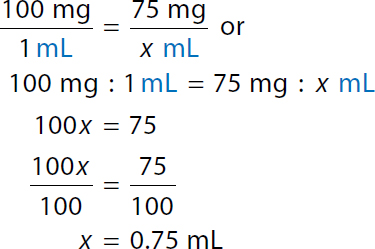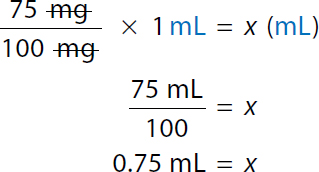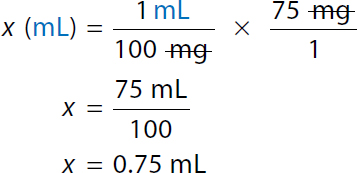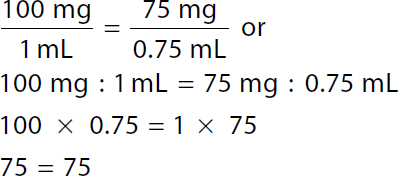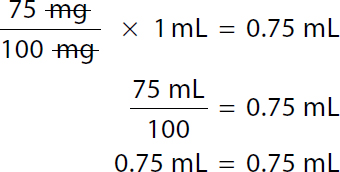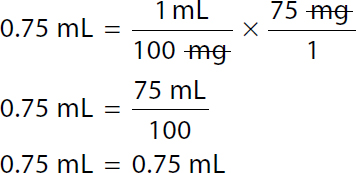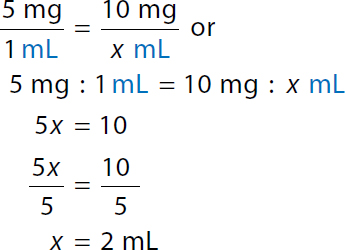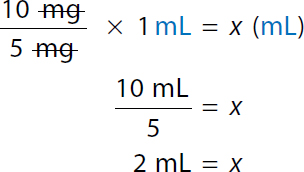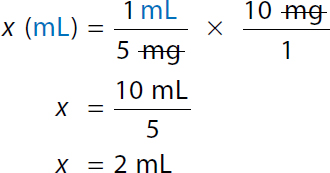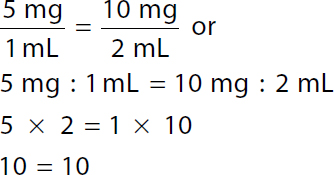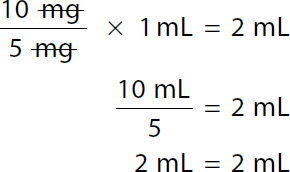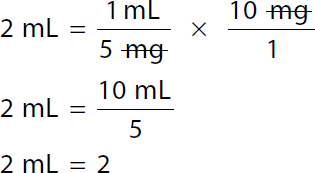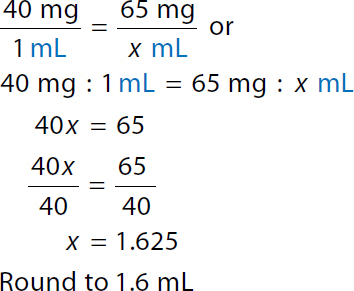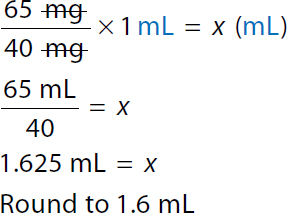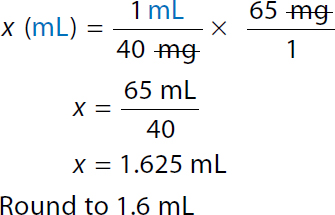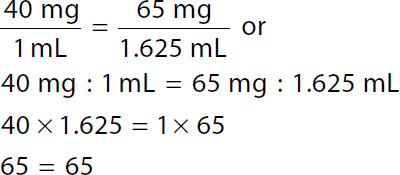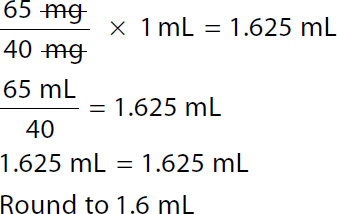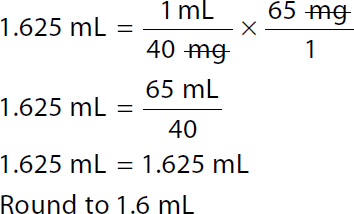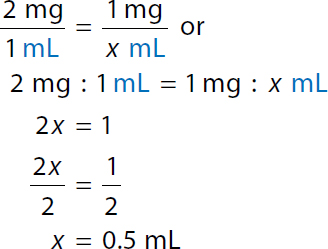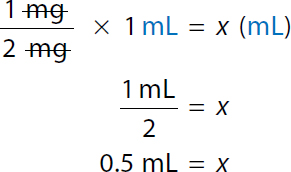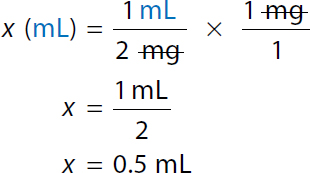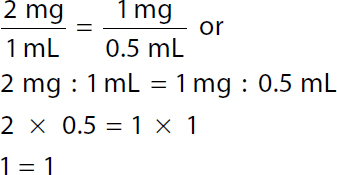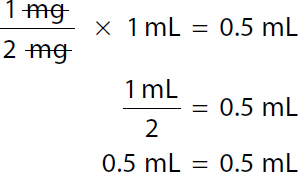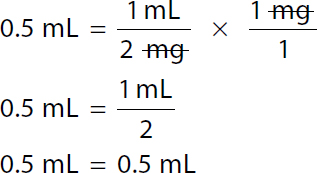Injectable medications are available as premixed solution or dry powder. A premixed solution contains a specified amount of medication diluted within a specified volume of solution that forms a concentration known as the dosage supply strength or supply dosage. Medications that are not stable for long periods of time when mixed are marketed as powdered medications that require reconstitution (reformation as a liquid). Some medications are available as powders that will need a certain volume of diluent (solvent, a liquid that dilutes) added to achieve the specified dosage strength. All medications must be in liquid form to be administered via the injection route.
Medication administration sites, as well as the age of the patient and the size of the muscle, affect the volume that can be administered, as indicated in Table 9-1. The volume of medication that is required to deliver the prescribed dose determines the size of the syringe to be used for administering the dose. Calibrations on the syringe vary by syringe size, as shown in Table 9-2. The nurse will round the amount to administer, based on the calibration of the syringe required to administer the correct volume of medication. For example, if the amount to administer is less than 1 mL, then a 1 mL syringe can be used. The 1 mL syringe is calibrated by hundredths, so the volume to administer will be rounded to hundredths. The 3 mL syringe, however, is calibrated to tenths, so amounts larger than 1 mL will be administered in a 3 mL syringe and will be rounded to tenths (Table 9-3).
Administration Route/Site | Maximum Volume |
|---|---|
Intradermal (ID) | 0.1 mL |
Subcutaneous (SUBQ) | 1 mL—adult 0.5 mL—child |
Intramuscular (IM) Adult: Vastus lateralis Ventrogluteal Deltoid Child: Vastus lateralis 6 to 12 years 0 to 5 years Premature infant |
3 mL 3 mL 1 mL
2 mL 1 mL 0.5 mL |
Syringe Size (Volume) | Calibration |
0.5 mL tuberculin syringe | Hundredth (0.01 mL) |
1 mL tuberculin syringe | Hundredth (0.01 mL) |
3 mL (standard syringe) | Tenth (0.1 mL) |
5 mL (large-volume syringe) | Two-tenths (0.2 mL) |
10 mL (large-volume syringe) | Two-tenths (0.2 mL) |
20 to 60 mL (large-volume syringes) | Whole number (1 mL) |
Volume to Be Administered | Syringe Size | Rounding Rules |
Less than 1 mL and does not calculate evenly to tenths — e.g., 0.432 mL | 1 mL or smaller Calibrated in hundredths — Use 1 mL syringe or 0.5 mL syringe. | Round to the nearest hundredth. — Round to 0.43 mL. |
Less than 1 mL, but greater than or equal to 0.5 mL, and volume calculates exactly in tenths — e.g., 0.9 mL | 1 mL or smaller (calibrated in hundredths) or 3 mL (calibrated in tenths) — Use 1 mL syringe or 3 mL syringe. | Do not round. Volume can be accurately measured in tenths—no rounding is needed. — Do not round. |
1 mL to 3 mL and does not calculate evenly to a whole number or to tenths — e.g., 1.432 mL | 3 mL (calibrated in tenths) — Use 3 mL syringe. | Round to the nearest tenth. — Round to 1.4 mL. |
The maximal volume that can be injected through a parenteral route, other than IV, is 3 mL; therefore, most calculations for injections, other than IV, will yield quantities of 3 mL or less. If more than 3 mL is needed to deliver the ordered dose intramuscularly, divide the amount to administer equally between two syringes for administration into separate IM sites.
Rounding RULE 9-1| When a dosage calculation yields a volume other than the calibration of the appropriate syringe, the volume must be rounded. Round the amount to administer to the calibration of the appropriate syringe. Rounding rules are summarized in Table 9-3. |
Example 1: For the following order and supply, determine the amount to administer and the appropriate syringe for administration.
Order: thiamine 75 mg IM tid
Supply: thiamine 100 mg/mL
C: Convert—Because the dose is ordered and supplied in milligrams, no conversion is required.
A: Approximate—The ordered dose, 75 mg, is  of the amount supplied in 1 mL. Therefore,
of the amount supplied in 1 mL. Therefore,  of the volume or 0.75 mL will be needed to administer the ordered dose.
of the volume or 0.75 mL will be needed to administer the ordered dose.
S: Solve
Ratio-Proportion | Formula Method |
|---|---|
A calculation to set the ratio-proportion of the ordered dosage of furosemide to administer. 100 milligrams over 1 milliliter equals 75 milligrams over x milliliter or a ratio of 100 milligrams to 1 milliliter equals a ratio of 75 milligrams to x milliliter. 100 x equals 75. 100 x over 100 equals 75 over 100. x equals 0.75 milliliter. |
A calculation to solve the amount of ordered dosage of thiamine to administer using the formula method. 75 milligrams over 100 milligrams times 1 milliliter equals x milliliter. In both the numerator and the denominator milligrams canceled each other. 75 milliliters over 100 equals x. 0.75 milliliter equals x. |
Dimensional Analysis | |
A calculation to solve the amount of ordered dosage of thiamine to administer using dimensional analysis. x milliliter equals 1 milliliter over 100 milligrams times 75 milligrams over 1. In both the numerator and the denominator milligrams canceled each other. x equals 75 milliliters over 100. x equals 0.75 milliliter. | |
Ratio-Proportion | Formula Method |
|---|---|
A calculation to set the ratio-proportion of the ordered dosage to administer. 100 milligrams over 1 milliliter equals 75 milligrams over 0.75 milliliter or a ratio of 100 milligrams to 1 milliliter equals a ratio of 75 milligrams to 0.75 milliliter. 100 times 0.75 equals 1 times 75. 75 equals 75. |
A calculation to find the amount of ordered dosage to administer using the formula method. 75 milligrams over 100 milligrams times 1 milliliter equals 0.75 milliliter. In both the numerator and the denominator milligrams canceled each other. 75 milliliters over 100 equals 0.75 milliliter. 0.75 milliliter equals 0.75 milliliter. |
Dimensional Analysis | |
A calculation to confirm the amount of ordered dosage to administer using dimensional analysis. 0.75 milliliter equals 1 milliliter over 100 milligrams times 75 milligrams over 1. In both the numerator and the denominator milligrams canceled each other. 0.75 milliliter equals 75 milliliters over 100. 0.75 milliliter equals 0.75 milliliter. | |
Because the calculated volume accurately completes the equation and is consistent with the approximated volume, 0.75 mL, the answer is confirmed.
The volume needed to administer a 75 mg dose is less than 1 mL and does not calculate evenly to tenths, so a 1 mL syringe is appropriate for administering this dose (Figure 9-4).
A 1 mL syringe containing 0.75 mL.
An illustration of a 1-milliliter syringe without a needle in a horizontal position with the plunger on the right.
Each .01 milliliter increment is further calibrated into 10 equal parts. The syringe contains medication 5 partitioned units to the right of 0.7.
Example 2: Determine the amount to administer for the following order and supply.
Order: diazepam 10 mg IM stat
Supply: diazepam 5 mg/mL
C: Convert—Because the dose is ordered and supplied in milligrams, no conversion is required.
A: Approximate—The ordered dose, 10 mg, is twice the amount supplied in 1 mL. Therefore, twice the volume, or 2 mL, will be needed to administer the ordered dose.
Ratio-Proportion | Formula Method |
|---|---|
A calculation to set the ratio-proportion of the ordered dosage of diazepam to administer. 5 milligrams over 1 milliliter equals 10 milligrams over x milliliter or a ratio of 5 milligrams to 1 milliliter equals a ratio of 10 milligrams to x milliliter. 5 x equals 10. 5 x over 5 equals 10 over 5. x equals 2 milliliters. |
A calculation to solve the amount of ordered dosage of diazepam to administer using the formula method. 10 milligrams over 5 milligrams times 1 milliliter equals x milliliter. In both the numerator and the denominator milligrams canceled each other. 10 milliliters over 5 equals x. 2 milliliters equals x. |
Dimensional Analysis | |
A calculation to solve the amount of ordered dosage of diazepam to administer using dimensional analysis. x milliliter equals 1 milliliter over 5 milligrams times 10 milligrams over 1. In both the numerator and the denominator milligrams canceled each other. x equals 10 milliliters over 5. x equals 2 milliliters. | |
E: Evaluate
Ratio-Proportion | Formula Method |
|---|---|
A calculation to set the ratio-proportion of the ordered dose to administer. 5 milligrams over 1 milliliter equals 10 milligrams over 2 milliliters or a ratio of 5 milligrams to 1 milliliter equals a ratio of 10 milligrams to 2 milliliters. 5 times 2 equals 1 times 10. 10 equals 10. |
A calculation to find the amount of ordered dose to administer using the formula method. 10 milligrams over 5 milligrams times 1 milliliter equals 2 milliliters. In both the numerator and the denominator milligrams canceled each other. 10 milliliters over 5 equals 2 milliliters. 2 milliliters equals 2 milliliters. |
Dimensional Analysis | |
A calculation to confirm the amount of ordered dose to administer using dimensional analysis. 2 milliliters equals 1 milliliter over 5 milligrams times 10 milligrams over 1. In both the numerator and the denominator milligrams canceled each other. 2 milliliters equals 10 milliliters over 5. 2 milliliters equals 2. | |
Because the calculated volume accurately completes the equation and is consistent with the approximated volume, 2 mL, the answer is confirmed.
The volume needed to administer a 10 mg dose is greater than 1 mL, so a 3 mL syringe is appropriate for administering this dose (Figure 9-5).
A 3 mL syringe containing 2 mL.
An illustration of a 3-milliliter syringe without a needle in a horizontal position with the plunger on the right.
Each 0.5-milliliter increment is further calibrated into 5 equal parts. The syringe contains medication up to 2 milliliters.
Example 3: Determine the amount to administer for the following order and supply.
Order: gentamicin 65 mg IM q8h
Supply: gentamicin 40 mg/mL
C: Convert—Because the dose is ordered and supplied in milligrams, no conversion is required.
A: Approximate—The ordered dose, 65 mg, is greater than the amount supplied in 1 mL, but less than the amount supplied in 2 mL. Therefore, a volume between 1 and 2 mL will be needed to administer the ordered dose.
S: Solve
Ratio-Proportion | Formula Method |
|---|---|
A calculation to set the ratio-proportion of the ordered dosage of gentamicin to administer. 40 milligrams over 1 milliliter equals 65 milligrams over x milliliter or a ratio of 40 milligrams to 1 milliliter equals a ratio of 65 milligrams to x milliliter. 40 x equals 65. 40 x over 40 equals 65 over 40. x equals 1.625. Round to 1.6 milliliters. |
A calculation to solve the amount of ordered dosage of gentamicin to administer using the formula method. 65 milligrams over 40 milligrams times 1 milliliter equals x milliliter. In both the numerator and the denominator milligrams canceled each other. 65 milliliters over 40 equals x. 1.625 milliliters equals x. Round to 1.6 milliliters. |
Dimensional Analysis | |
A calculation to solve the amount of ordered dosage of gentamicin to administer using dimensional analysis. x milliliter equals 1 milliliter over 40 milligrams times 65 milligrams over 1. In both the numerator and the denominator milligrams canceled each other. x equals 65 milliliters over 40. x equals 1.625 milliliters. Round to 1.6 milliliters. | |
E: Evaluate
Ratio-Proportion | Formula Method |
|---|---|
A calculation to set the ratio-proportion of the gentamicin ordered dose to administer. 40 milligrams over 1 milliliter equals 65 milligrams over 1.625 milliliters or a ratio of 40 milligrams to 1 milliliter equals a ratio of 65 milligrams to 1.625 milliliters. 40 times 1.625 equals 1 times 65. 65 equals 65. |
A calculation to find the amount of ordered dose to administer using the formula method. 65 milligrams over 40 milligrams times 1 milliliter equals 1.625 milliliters. In both the numerator and the denominator milligrams canceled each other. 65 milliliters over 40 equals 1.625 milliliters. 1.625 milliliters equals 1.625 milliliters. Round to 1.6 milliliters. |
A calculation to check the amount of ordered dose to administer using dimensional analysis. 1.625 milliliters equals 1 milliliter over 40 milligrams times 65 milligrams over 1. In both the numerator and the denominator milligrams canceled each other. 1.625 milliliters equals 65 milliliters over 40. 1.625 milliliters equals 1.625 milliliters. Round to 1.6 milliliters. | |
Because the calculated amount, 1.6 mL, accurately completes the equation and is consistent with the approximated amount, between 1 and 2 mL, the answer is confirmed.
The volume needed to administer a 65 mg dose is greater than 1 mL, so a 3 mL syringe is appropriate for administering this dose (Figure 9-6).
A 3 mL syringe containing 1.6 mL.
An illustration of a 3-milliliter syringe without a needle in a horizontal position with the plunger on the right.
Each 0.5-milliliter increment is further calibrated into 5 equal parts. The syringe contains medication up to 1 partitioned unit to the right of 1.5 milliliters.
Example 4: Determine the amount to administer for the following order and supply.
Order: lorazepam 1 mg IM one-time dose, 2 h before surgery
Supply: lorazepam 2 mg/mL
C: Convert—Because the dose is ordered and supplied in milligrams, no conversion is required.
A: Approximate—The ordered dose, 1 mg, is half the amount supplied in 1 mL. Therefore, half of the volume, or 0.5 mL, will be needed to administer the ordered dose.
S: Solve
Ratio-Proportion | Formula Method |
|---|---|
A calculation to set the ratio-proportion of the ordered dosage of lorazepam to administer. 2 milligrams over 1 milliliter equals 1 milligram over x milliliter or a ratio of 2 milligrams to 1 milliliter equals a ratio of 1 milligram to x milliliter. 2 x equals 1. 2 x over 2 equals 1 over 2. x equals 0.5 milliliter. |
A calculation to solve the amount of ordered dosage of lorazepam to administer using the formula method. 1 milligram over 2 milligrams times 1 milliliter equals x milliliter. In both the numerator and the denominator milligrams canceled each other. 1 milliliter over 2 equals x. 0.5 milliliter equals x. |
A calculation to solve the amount of ordered dosage of lorazepam to administer using dimensional analysis. x milliliter equals 1 milliliter over 2 milligrams times 1 milligram over 1. In both the numerator and the denominator milligrams canceled each other. x equals 1 milliliter over 2. x equals 0.5 milliliter. | |
E: Evaluate
Ratio-Proportion | Formula Method |
|---|---|
A calculation to set the ratio-proportion of the lorazepam ordered dose to administer. 2 milligrams over 1 milliliter equals 1 milligram over 0.5 milliliter or a ratio of 2 milligrams to 1 milliliter equals a ratio of 1 milligram to 0.5 milliliter. 2 times 0.5 equals 1. 2 times 0.5 equals 1 times 1. 1 equals 1. |
A calculation to determine the amount of ordered dose to administer using the formula method. 1 milligram over 2 milligrams times 1 milliliter equals 0.5 milliliter. In both the numerator and the denominator milligrams canceled each other. 1 milliliter over 2 equals 0.5 milliliter. 0.5 milliliter equals 0.5 milliliter. |
Dimensional Analysis | |
A calculation to check the volume of ordered dose to administer using dimensional analysis. 0.5 milliliter equals 1 milliliter over 2 milligrams times 1 milligram over 1. In both the numerator and the denominator milligrams canceled each other. 0.5 milliliter equals 1 milliliter over 2. 0.5 milliliter equals 0.5 milliliter. | |
Because the calculated volume accurately completes the equation and is consistent with the approximated volume, 0.5 mL, the answer is confirmed.
The volume needed to administer a 1 mg dose is less than 1 mL and calculates evenly to the tenths, so both a 1 mL syringe (Figure 9-7) and a 3 mL syringe (Figure 9-8) are appropriate for administering this dose.
A 1 mL syringe containing 0.5 mL.
An illustration of a 1-milliliter syringe without a needle in a horizontal position with the plunger on the right.
Each 0.1 milliliter increment is further calibrated into 10 equal parts. The syringe contains medication up to 0.5 milliliter.
A 3 mL syringe containing 0.5 mL.
An illustration of a 3-milliliter syringe without a needle in a horizontal position with the plunger on the right.
Each 0.5 milliliter increment is further calibrated into 5 equal parts. The syringe contains medication up to 0.5 milliliter.
LEARNING ACTIVITY 9-2 For each order and supply, determine the volume to administer and mark the appropriate syringe with that volume.
1.Order: 25 mg Supply: 50 mg/mL Volume to administer: ____________
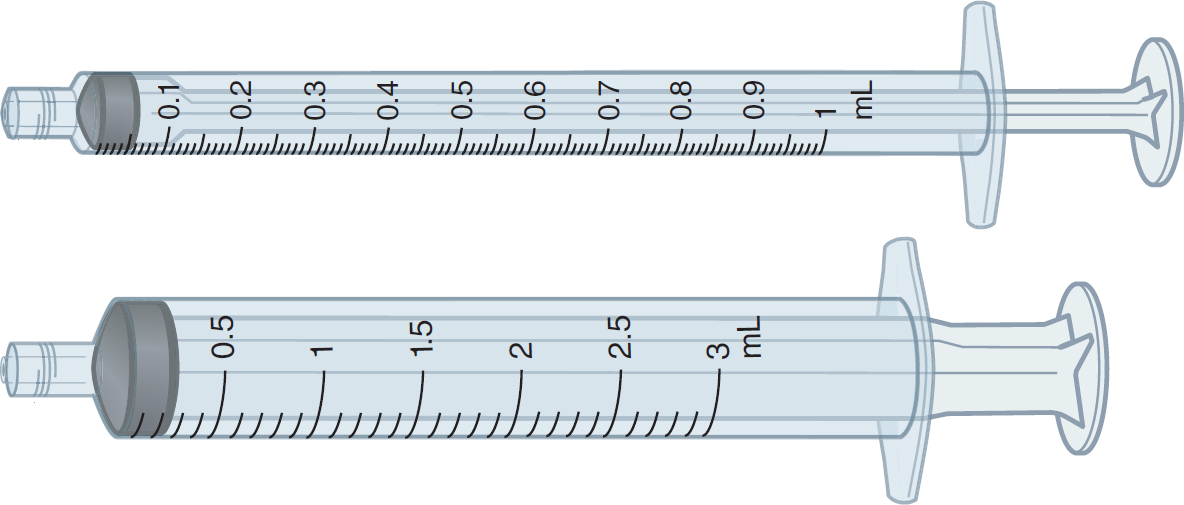
An illustration of a 1-milliliter syringe without a needle in a horizontal position with plungers on the right.
The syringe is incremented by 0.1 milliliters and calibrated into 10 equal parts. The syringe does not have medications.
2.Order: 12 mg Supply: 22 mg/mL Volume to administer: ____________
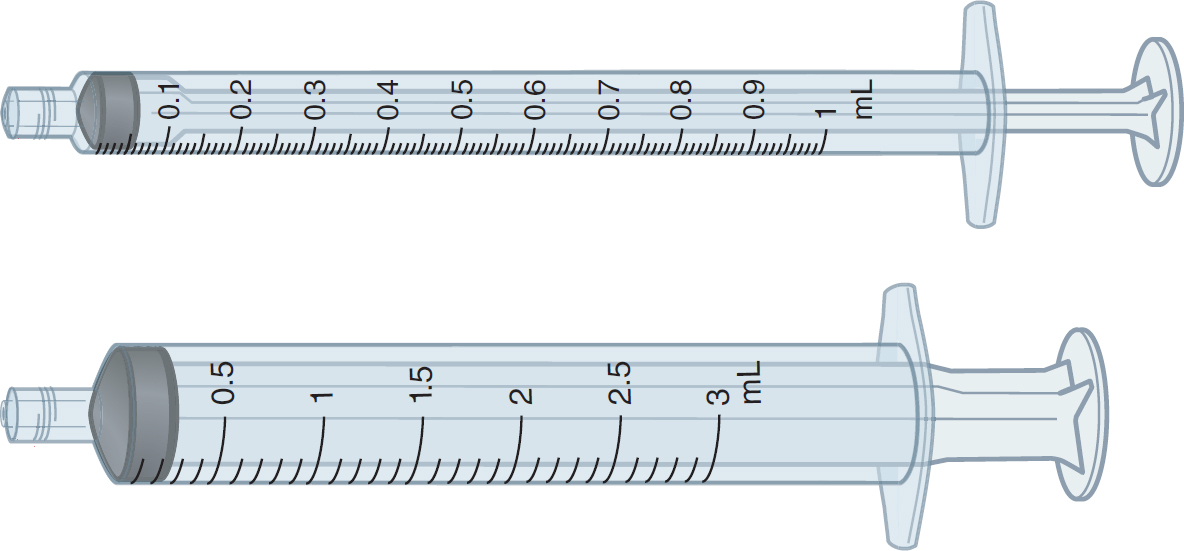
An illustration of a 3-milliliter syringe without a needle in a horizontal position with plungers on the right. An illustration of a 1-milliliter syringe and without a needle in a horizontal position with plungers on the right. An illustration of a 3-milliliter syringe without a needle in a horizontal position with plungers on the right. A label of 5 milliliters single dose vial for intravenous use Metoprolol 5 milligrams per 5 milliliters Tartrate Injection, U S P, 1 milligram per milliliter.
The syringe is incremented by 0.5 milliliters and calibrated into 10 equal parts. The syringe does not have medications. The syringe is incremented by 0.1 milliliters and calibrated into 10 equal parts. The syringe does not have medications. The syringe is incremented by 0.5 milliliters and calibrated into 10 equal parts. The syringe does not have medications. Instruction on the label reads, Latex-free. Sterile, Nonpyrogenic, Preservative-free. Each 5-milliliter vial contains 5 milligrams metoprolol tartrate, 45 milligrams sodium chloride, Water for Injection. See package insert for Dosage and Administration. Store at 20 degrees to 25 degrees Celsius or 68 to 77 degrees Fahrenheit. See U S P Controlled Room Temperature. Protect from light. Discard unused portion.
3.Order: 30 mg Supply: 20 mg/mL Volume to administer: ____________
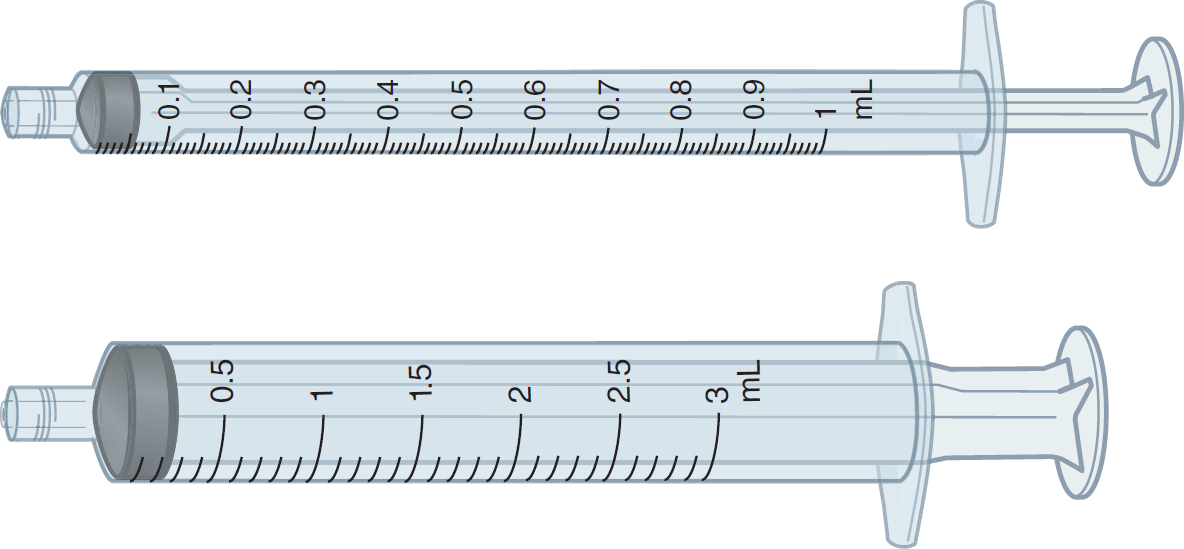
An illustration of a 1-milliliter syringe without a needle in a horizontal position with plungers on the right. An illustration of a 3-milliliter syringe without a needle in a horizontal position with plungers on the right.
The syringe is incremented by 0.1 milliliters and calibrated into 10 equal parts. The syringe does not have medications. The syringe is incremented by 0.5 milliliters and calibrated into 10 equal parts. The syringe does not have medications.
